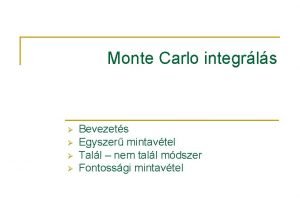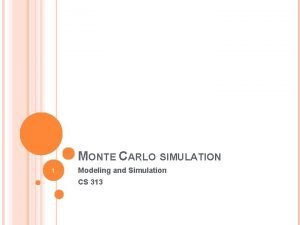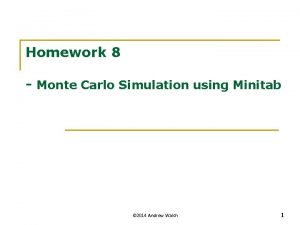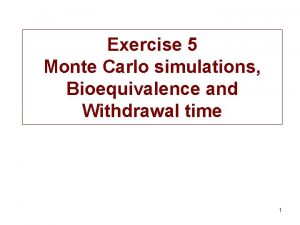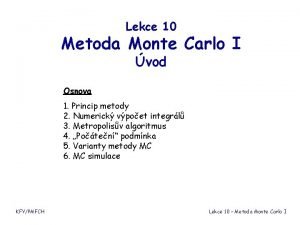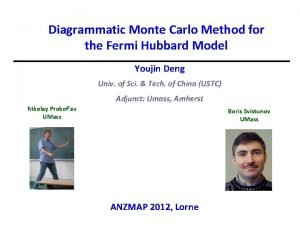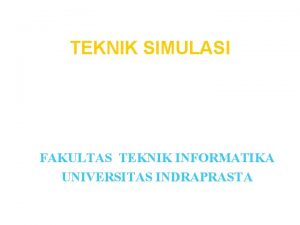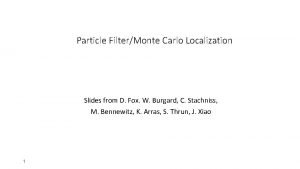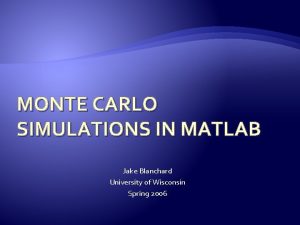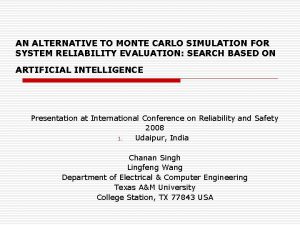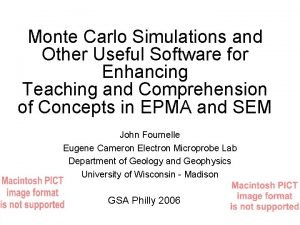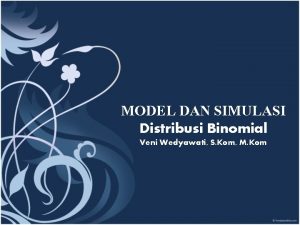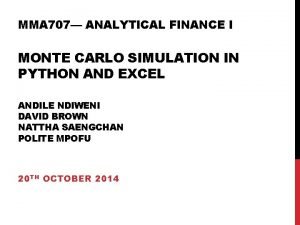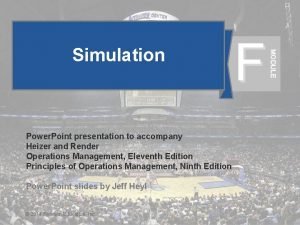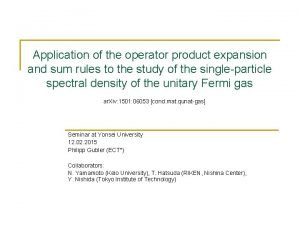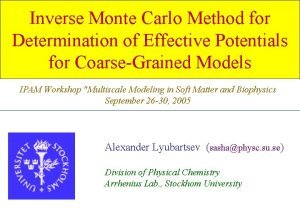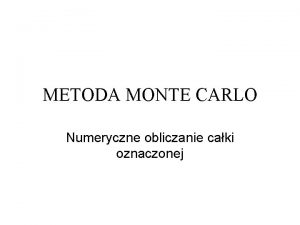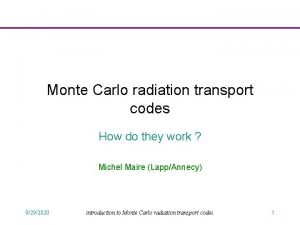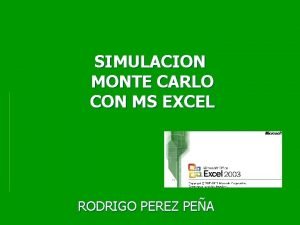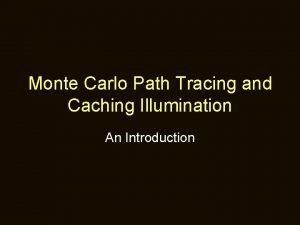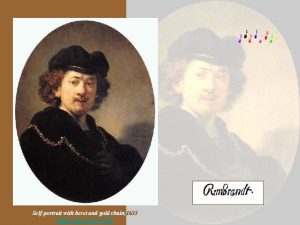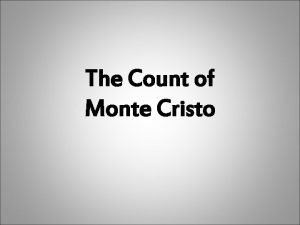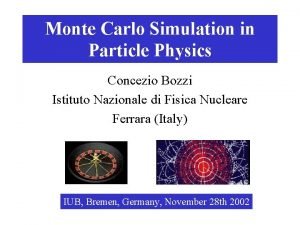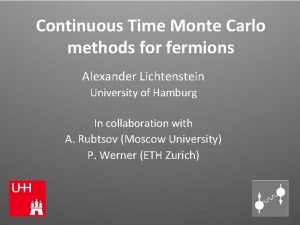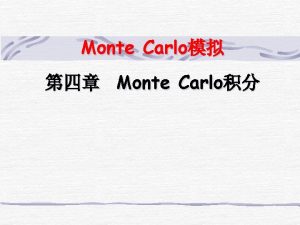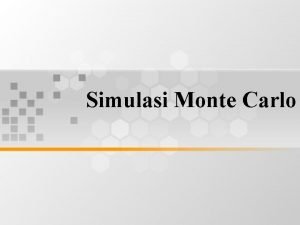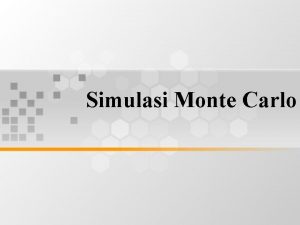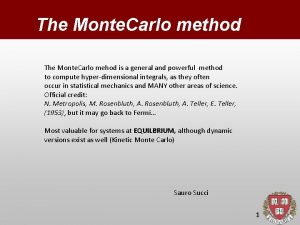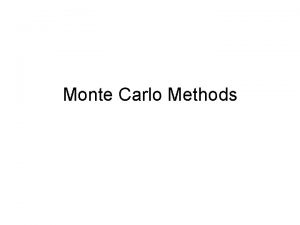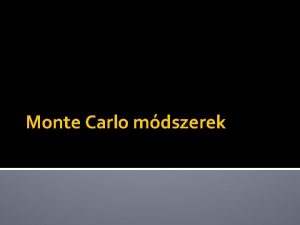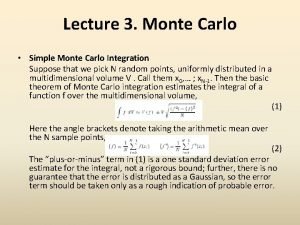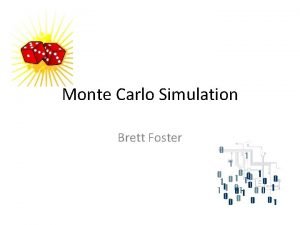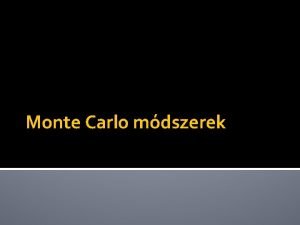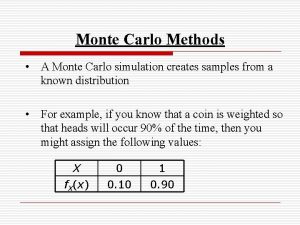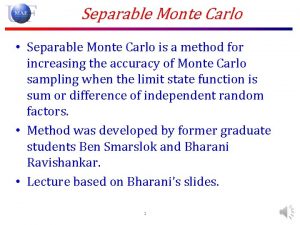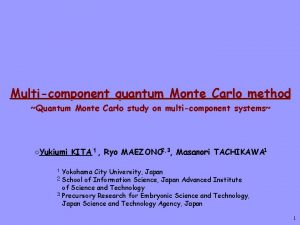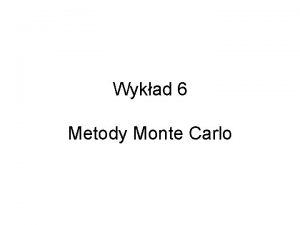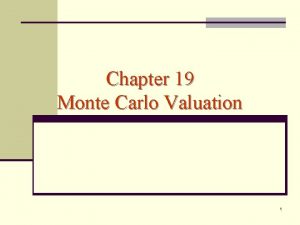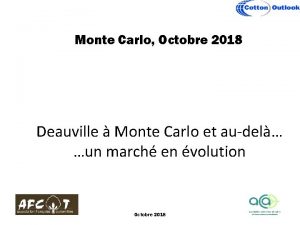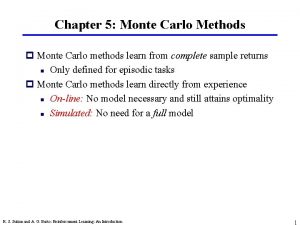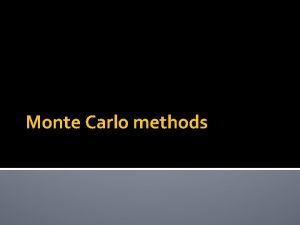Monte Carlo Tuning The HERA Experience Monte Carlo



























- Slides: 27

Monte Carlo Tuning: The HERA Experience • Monte Carlo Models for DIS events • Description of inclusive hadronic final state • Parameter tuning for Ariadne, Herwig, Lepto • Jets at high Q 2 and small x Ursula Bassler, LPNHE-Paris, RUN II MC workshop 1

Modeling ep interactions • proton structure: pdf • hard interaction: LO ME calculation at O( S) • QCD radiation: Parton Shower Models, Color Dipole Model • hadronisation: String or Cluster fragmentation 2

Parton Density Functions • strong constraints from structure function measurements • pdf’s determined with global fit programs: MRST, CTEQ hadronic final state is a good probe for QCD models independent of pdf’s. 3

MC Models at HERA: • MC Models used for DIS: Lepto, Ariadne, Herwig, Rapgap • MC Models used for p: Pythia, Phojet • MC Models at Small x: LDCMC, Smallx, Cascade • MC Models for diffraction: Rapgap, Lepto SCI, Ridi, Diff. VM 4

Where it started from… 92 • first hadronic final state measurements with Lint= 1. 6 nb-1 • transverse energy flow in the laboratory frame w. r. t. and e • comparison to various models: • Leading Log Parton Showers with max. virtuality scale Q 2 (LEP) or W 2 (Lepto 5. 2) • O( s) matrix element and parton shower (Lepto 6. 1) • Color Dipole Model (Ariadne 4. 03)! 5

Where it got to…. • transverse energy flow from 1994 data L=2. 7 pb-1 • 3. 2 < Q 2 < 2200 Ge. V 2 8· 10 -5 < x < 0. 11 increased precision requires improved understanding of Monte Carlo Models fine tuning of MC parameters possible and necessary 6

7

Inclusive hadronic final state G. Grindhammer et al: Comparison of energy flow and particle spectra in the hadronic CMS p * • Lorentz transformation from lab frame • Ariadne, Lepto, Rapgap and Herwig compared for various parameter sets 8

Lepto 6. 5 • ME calculation reproduce cross-sections • QCD cascade: – DGLAP based leading-log parton showers – strong ordering of gluons in kt • fragmentation: – JETSET - string model • parameters: – “Soft Color Interaction” between partons from hard interaction and proton remnant – “Generalized Area Law”: allows interactions between color string pieces 9

Rapgap 2. 06/48 • originally developed for description of diffractive events • takes into account direct and resolved virtual photon contributions • QCD cascade/fragmentation: – similar to Lepto • parameters: – resolved process scale = pt(jet)2+Q 2 – matrix element cut-off: PT 2 CUT=4 Ge. V 2 10

Herwig 5. 9 • QCD cascade: – coherent parton cascade with LO ME corrections – LO shower, but NLO S running • fragmentation: – cluster fragmentation • parameters: – strongly constraint from e+e- data – CLMAX: maximum cluster mass – PSPLT: cluster splitting 11

Ariadne 4. 10 • QCD cascade: based on the color dipole model – gluon emission from independently radiating dipoles – no ordering of gluons in k. T, BFKL emulation – gluon emission corrected to reproduce ME O( s) • fragmentation: JETSET • parameters: – PARA(10): suppression of soft gluon emission for proton remnant – PARA(15): for the struck quark – PARA(25): gluon emission outside suppression cut 12

Transverse Energy Flow Q 2 = 3. 2 Ge. V 2 14. 1 Ge. V 2 175 Ge. V 2 x= 0. 8 10 -4 0. 63 10 -3 0. 4 10 -2 proton remnant 2200 Ge. V 2 0. 11 • peaking ET in “current jet” region with rising Q 2 • plateau behavior at low Q 2 G. Grindhammer et al. A: 99/1 p(10) 1. 6 p(15) 0. 5 p(25) 1. 4 99/2 p(10) 1. 2 p(15) 1. 0 p(25) 1. 0 sgsr sgsc prob H: LO: CLMAX 3. 35 PSPLT 1. 0 96: CLMAX 5. 5 PSPLT 0. 65 99/1: CLMAX 3. 0 PSPLT 1. 2 99/2: CLMAX 5. 0 PSPLT 1. 0 Data: H 1 Eur. Phys. J C 12 (2000) 13

Charged particle multiplicity Q 2 = 7 Ge. V 2 x= 1. 6 10 -4 14 Ge. V 2 0. 64 10 -3 32 Ge. V 2 2. 1 10 -3 • reasonable descriptions can be found for all models • Herwig shows large variations depending on input parametrs G. Grindhammer et al. proton remnant Data: H 1 Nucl. Phys. B 485 (1997) 14

Charged particles multiplicities Q 2 = 7 Ge. V 2 x= 1. 6 10 -4 G. Grindhammer et al. proton remnant 14 Ge. V 2 0. 64 10 -3 32 Ge. V 2 2. 1 10 -3 • p*t > 1 Ge. V • only Ariadne and the high CLMAX parameter sets of Herwig give a good description Data: H 1 Nucl. Phys. B 485 (1997) 15

Pt spectrum Q 2 = 7 Ge. V 2 x= 1. 6 10 -4 14 Ge. V 2 0. 64 10 -3 32 Ge. V 2 2. 1 10 -3 • 0. 5 < * < 1. 5 G. Grindhammer et al. • difficulties at high pt for low Q 2 • only Ariadne describes the full phase space Data: H 1 Eur. Phys. J C 12 (2000) 16

MC parameter tuning N. H Brook et al. : tuning on hadronic final state variables in various Q 2 regions: • x. P in current region of the Breit frame • ET flow in hadronic center of mass system • event shape variables: thrust TC and TZ, jet broadening Bc, jet mass C • fragmentation function • differential and integrated jet shapes • di-jet production cross-sections • charged particle distributions compute combined 2 for all variables difficulties in describing simultaneously jets and charged particle distributions 17

NH. Brook et al. Ariadne: suppression of soft gluon emission for proton remnant P(10) • sensitive to di-jet cross-section • default parameter: Et spectra too hard at low Q 2 • increasing P(10): - suppression of ET over whole range - effect at low and high ET 18

Ariadne: gluon emission outside suppression cut-off P(25) • decreasing P(25): - larger changes at high ET - effect larger in fwd region • less sensitive to ET flow N. H. Brook et al. default tuned P(10) 1. 0 P(15) 1. 0 P(25) 2. 0 1. 6 0. 5 1. 4 19

Herwig: fragmentation parameters • LO s improves agreement PSPLT: increases ET flow CLMAX: • broader jets • harder momentum spectra for charger particles • no parameter set has been found describing all aspects of DIS data 20

Lepto: improved SCI • modified SCI (Lepto 6. 5. 2 ) suppressing SCI at high Q 2 • improved 2 by a factor ~5 • further improvement on (2+1) jet data varying PARL(8)=zpmin PARL(9)=ŝmin • But: other hadronic final state variables better described by default setting = 1/2(1 -cos *) 21

Jets at high Q 2 • 640 < Q 2 < 35000 Ge. V 2 • MC models used with optimized parameters • zp, xp distributions most sensitive to differences in the models • best description of data by Ariadne modified Durham algorithm 22

Jets in Charged Current Events • event selection in same kinematic region, but smaller cross-section • similar behavior of jets than in Neutral Current • stronger deviations seen for LEPTO w. r. t to data and other models 23

Parton Cascades at small x DGLAP: resummation of ln. Q 2 strong ordering in k. T BFKL: resummation of ln 1/x no ordering in k. T CCFM: color coherence strong angular ordering additional transverse energy in forward direction produced for BFKL and CCFM approach BFKL/CCFM in MC models: Ariadne, LDCMC, Smallx, Cascade 24

Forward Jets at small x • rise of jet crosssection with decreasing x, underestimated by MC Models • Lepto/Herwig and LDCMC predict smaller cross-sections • Ariadne and Rapgap show reasonable agreement 25

CCFM evolution - Cascade • CCFM equation implemented in backward evolution schema • forward jets: - good description for H 1 cross-section - above ZEUS measurement H. Jung, G. P Salam 26

Conclusions • MC tuning at HERA not yet to the precision of LEP, but – hadronic environment probed with a lepton – ongoing progress in understanding of various aspects in hadronic final state – further high precision measurements • ARIADNE gives overall a good picture of DIS events • useful experience for hadron colliders? ! 27
 Monte carlo search tree
Monte carlo search tree Monte carlo szimuláció példa
Monte carlo szimuláció példa Equilikely
Equilikely Monte carlo simulation minitab
Monte carlo simulation minitab Monte carlo exercise
Monte carlo exercise Metoda monte carlo
Metoda monte carlo Metode monte carlo dan contohnya
Metode monte carlo dan contohnya Diagrammatic monte carlo
Diagrammatic monte carlo Bangkitkan 5 bilangan random menggunakan metode mid square
Bangkitkan 5 bilangan random menggunakan metode mid square Monte carlo localization python
Monte carlo localization python Monte carlo integration matlab
Monte carlo integration matlab Monte carlo simulation alternatives
Monte carlo simulation alternatives Monte carlo simulation freeware
Monte carlo simulation freeware Contoh soal simulasi monte carlo
Contoh soal simulasi monte carlo Monte carlo simulation
Monte carlo simulation Monte carlo simulation advantages and disadvantages ppt
Monte carlo simulation advantages and disadvantages ppt Quantum monte carlo
Quantum monte carlo Inverse monte carlo
Inverse monte carlo Mnemstudio
Mnemstudio Metoda monte carlo algorytm
Metoda monte carlo algorytm Monte carlo radiation transport
Monte carlo radiation transport Simulacion monte carlo en excel
Simulacion monte carlo en excel Monte carlo ray tracing
Monte carlo ray tracing Bushy hair
Bushy hair Count of monte carlo
Count of monte carlo Monte carlo simulation particle physics
Monte carlo simulation particle physics Contoh simulasi monte carlo
Contoh simulasi monte carlo Continuous time monte carlo
Continuous time monte carlo

